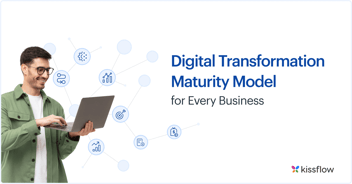
- >
- Digital Transformation >
- The Digital Transformation Framework: A Roadmap for Scaling Your Business
The Digital Transformation Framework: A Roadmap for Scaling Your Business
Team Kissflow
Updated on 17 Mar 2025 • 6 min read
Building a digital transformation framework doesn’t mean altering your technology stacks, automating reports, or switching technologies for the sake of it. The framework is simply an avenue to get to your destination. You have to avoid assumptions that changing how you do things will automatically transform you digitally.
To experience successful digital transformation, you need to first understand your digital maturity. The digital maturity scale essentially elucidates where a company is in terms of technological or digital integration. And while digital transformation is an unachievable final frontier, the scale clarifies how close a company is to it.
Need help navigating the complexities of digital transformation? This article offers a step-by-step guide using a proven digital transformation framework. Learn how to create a repeatable method for streamlining the process and maximizing its impact on your organization.
What is a digital transformation framework?
A digital transformation framework is a strategic plan that guides organizations to reimagine work in order to drive large-scale cultural and technological change. Focusing on driving organizational and technological development, the plan aims to enhance productivity, value delivery, and operational efficiency.
The digital transformation framework generally means a well-planned long-term strategy for how a business users will address the complex challenges posed during the transition to the digital world.
Once you understand where you are on this journey, the next step is to reimagine work. Let’s say you’re deploying an email automation system to strengthen customer relationships and build brand loyalty. But you’re measuring the success of your new change based on your old KPIs. Measuring the same results using a new system does not necessarily equate to achieving better results.
To achieve success with digital transformation efforts, Deloitte[1] explains that an organization needs to speak a common language that all stakeholders understand. The language must surpass any individual technology. It must go straight to the heart of the processes, culture, and how people work and interact. All this is only possible with a proper digital transformation framework.
A digital transformation framework is important for several reasons:
Roadmap and Strategy:
It acts as a roadmap, guiding businesses through the complex digital transformation process. It includes defining goals, prioritizing initiatives, and making informed decisions about technology adoption.
Reduced Risk:
By providing a structured approach, the framework helps mitigate risks associated with digital transformation. It ensures a focus on business goals and prevents getting sidetracked by shiny new technologies.
Improved Efficiency:
The framework streamlines the transformation journey, making it more achievable and efficient. It avoids wasting time and resources on redundant efforts and helps prioritize tasks effectively.
Alignment and Communication:
It fosters better alignment and communication across different departments within an organization. Everyone involved understands the overall vision and goals of the transformation process.
Adaptability:
A good framework is adaptable to changing circumstances. It allows businesses to integrate new technologies and adjust their strategies as needed, keeping them competitive in the digital age.
Examples of popular digital transformation frameworks
1. McKinsey's 4Ds Framework
The framework focuses on four key stages of digital transformation:
- Discover: It involves developing your business strategy based on customer insights and market trends.
- Design: Here, you create and prototype new digital experiences that will enhance the customer journey.
- Deliver: This stage is about building and implementing your digital solutions, often in collaboration with partners.
- De-risk: The final stage involves managing risks and ensuring the ongoing success of your digital transformation efforts.
2. MIT Sloan Management Review's Digital Transformation Framework
This framework identifies five key dimensions that are crucial for successful digital transformation:
- Customer experience: Focuses on using digital technologies to improve customer interactions and satisfaction.
- Business model innovation: Analyzes how digital technologies can create new revenue streams or disrupt existing business models.
- Data and analytics: Leverages data to gain insights, improve decision-making, and personalize experiences.
- Technology and architecture: Ensures the right technology infrastructure is in place to support digital initiatives.
Workforce capabilities: Develop the skills and capabilities of your workforce to thrive in a digital environment.
These are just two examples, and there are many other Digital transformation frameworks available. The best framework for your organization will depend on your specific goals and challenges.
How to create a digital transformation framework?
Digital transformation strategies guide an organization to transform itself via a sequence of clearly defined goals and objectives (business size, customers, and current digital maturity). Only then can the organization stay ahead of the curve and thrive in a highly competitive marketplace.
Elements to consider to build a Framework
Employees
Employees who have digital literacy will have a deep understanding of the platforms, applications, and collaborative tools utilized by the organization. More importantly, they’ll know how to deliver business objectives by using these technologies.
An ongoing education and training plan should be part of the company culture to help current employees become proficient and productive and understand the value of these new processes. Ensure your talent feels informed and included to motivate and align them with your vision.
Technology
Enterprise technology can seem complex and intimidating for companies adapting to it. For organizations undergoing digital transformation, facing this issue ranks among the biggest challenges.
Choosing the right tech is critical from the perspectives of implementation, scalability, data integration, and end-user experience. So, you must consider these aspects from the beginning of your transformation project and look out for the most intuitive solutions.
Most solutions in the market are cloud-based. And while there are some applications for on-premise solutions, it is advisable to shift to cloud technology simply because of the advantages it brings.
Strategy
Why are you replacing legacy systems and other manual processes with a new digital system? Do you need or have a plan to implement advanced and complex systems? Are you ready to properly migrate your existing systems to a new one
These are some of the important questions you must answer before creating a digital transformation framework. A digital transformation project will not be successful without a predetermined strategy. Only if you have a clear strategy can you identify which areas can be improved and upgraded.
Customer
Customer-centricity is achieved by combining customer focus and business purpose (strategy, capabilities, and culture).
Viewing a business from a customer’s vantage will stop internal divisions and cultural differences from getting in the way of customer experience. Such an alignment will lead to the following benefits:
- Reduced friction from the buyer’s journey
- Personalized customer experience
- True, authentic value delivery
- Improved data integrity and security
Steps to build your digital transformation framework
For these reasons, a digital transformation framework cannot be a one-size-fits-all approach. An adaptable goal-based framework is always best for aligning your strategy for digital execution.
Here are the essentials for building a successful digital transformation framework.
1. Evaluating the current stage
First and foremost, you need to evaluate your company’s standing at the base.
- What’s driving the need for digital transformation?
- What isn’t working at your organization?
- What objectives need to be met? And across which areas of the business?
- What changes can be expected with the newly implemented technology, and how its success will be measured?
- How will the changes affect customer behavior?
- How will enforcing changes likely affect your short- and long-term goals?
All of this will help you identify inconsistencies that need to be filled in. In turn, you’ll be able to identify the specific technologies that could be most effective in benefiting the organization.
The next stage is to develop strategies.
2. Develop strategies
Companies make the mistake of giving too much attention to specific technologies to enhance operations instead of creating a holistic strategy that can transform a business across all systems and processes.
Digital transformation will be a disappointment if shiny technologies are layered onto broken processes and teams that are resistant to change. A successful integrated strategy should:
- Define the purpose of digital transformation
- Build a digital mindset into the foundation
- Enable leaders to manage change
- Create a realistic map of timelines and deliverables
- Outline a custom tech and data synergy plan
3. Organizational alignment
Organizational alignment is another fundamental prerequisite of digital transformation as it’s impossible to implement digital strategy without proper alignment.
Establishing a cooperative culture will prepare employees for change and will keep them aligned and motivated. Otherwise, introducing technology into a workforce too quickly or with too many moving pieces at once could lead to information overload for your team.
The general process followed to achieve organizational alignment:
- Vision declaration
- Goal setting
- Collaborative ideation
- KPI development
- Culture/change management planning
- Role definition
4. Hire talents
The right employees have the power to accelerate digital transformation. When you maximize technology investment, you need to find the talent that understands it. To achieve success in your digital transformation efforts, you must have skilled employees in your organization who know how to navigate change.
So, to hire the right talent, the recruitment process needs to be optimized for digital transition. It will be applicable to pretty much every job in the organization, from C-level executives to developers, project managers, and digital marketers.
5. Proper investment
Digital transformation includes a considerable amount of investment. If you have a substandard investment strategy, it will take considerably more to close the gap at a later point. Apart from this, any other added consultation work shifts in your customer requirements, as well as other IT errors, will compound the problem. Hence, it is crucial to understand your short-term and long-term goals clearly. When you understand this, you’ll be able to figure out the areas where spending is high and the areas where your budget needs to be increased.
Have a clear understanding of your budget spending and identify opportunities for consolidation. Invest in learning about the tools that have evolved and understanding the potential intersection between current and future IT spending for digital transformation initiatives. You can remain flexible and agile while also delivering enhanced speed for digital maturity.
How Kissflow can help?
For a true transformation, business changes should be reflected in the outcomes and must be aligned with what you’re transforming into. To deliver value continuously, a custom digital transformation strategy, along with a proper framework, is required.
There’s quite a lot of work and challenges involved in this process. So it’s a good idea to get help from digital transformation catalysts like Kissflow.
Kissflow’s digital transformation platform helps you take the next step in your digital transformation journey. Not only does it address multiple use cases, such as application development and process automation, but it does so in a simple, smart, and efficient manner.
Your step-by-step roadmap to drive innovation, enhance agility, and achieve operational excellence. Explore the framework now!
Related Articles











